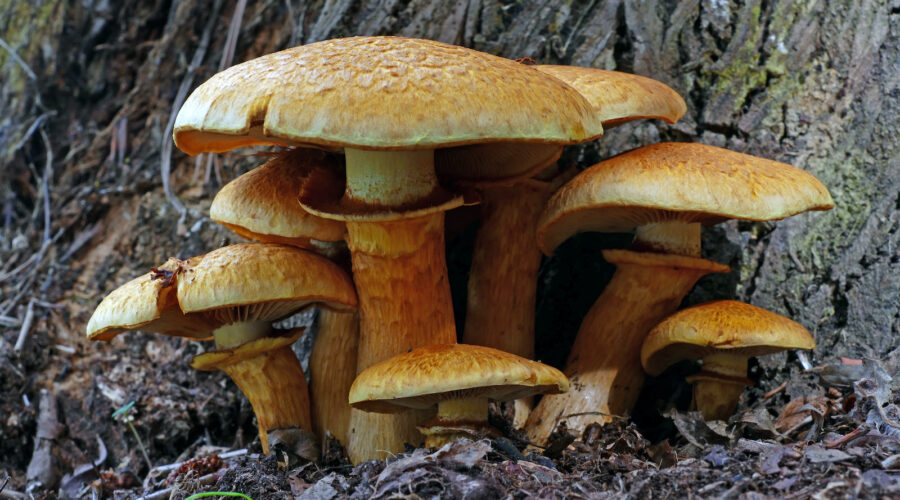Low Potency Laughter: What People Like and Don’t Like About Laughing Gym Mushrooms
Gymnopilus junonius (also known as Gymnopilus spectabilis or the laughing gym mushroom) is a species of mushroom that belongs to the family Cortinariaceae. It is also commonly referred to as the spectacular rustgill or big laughing gym mushroom.
Interested in joining a Psychedelics Clinical Trial? Sign up here now and we will connect you with a clinical trial in your area when one becomes available.
What People Are Saying About Laughing Gym Mushrooms
What People Like About Laughing Gym Mushrooms:
- They Grow Naturally Everywhere: They grow naturally in the wild in many parts of the world, which can make for an enjoyable foraging experience.
- You Will Laugh…A Lot: As the name suggests, Laughing Gym mushrooms have been reported to induce episodes of uncontrollable laughter, which some users find to be a pleasurable effect.
- It’s Not Super Heavy: For those looking for a less intense psychedelic experience, the Laughing Gym may provide a more moderate effect compared to stronger species like Golden Teachers and Penis Envy.
- They Look Great: They are often admired for their bright, eye-catching colors and can be a beautiful sight when found in the wild.
What People Don’t Like About Laughing Gym Mushrooms:
- Bitter Taste: The mushrooms are known for their very bitter taste, which can be off-putting for many people.
- Difficult Identification: For foragers, correctly identifying Laughing Gym can be challenging, and mistaking it for a toxic mushroom could have serious health consequences.
- Unpleasant Effects: Besides the lower psychoactive potency, they can cause unpleasant effects such as nausea, stomach cramps, or vomiting.
- Legal Status: Like other psychoactive mushrooms, Laughing Gym may fall under drug control laws in many jurisdictions, making possession, cultivation, or use a legal risk.
- Lack of Research: There is limited research on the effects of Laughing Gym, which means less is known about its safety profile and potential risks compared to more commonly used psychedelic mushrooms.
This species may not contain the psychedelic compounds psilocybin and psilocin (which we will explore in more detail), although several subspecies and lookalikes do. The laughing gym mushroom, as well as some of its subspecies, also contains neurotoxic oligoisoprenoids, including gymnopilin.
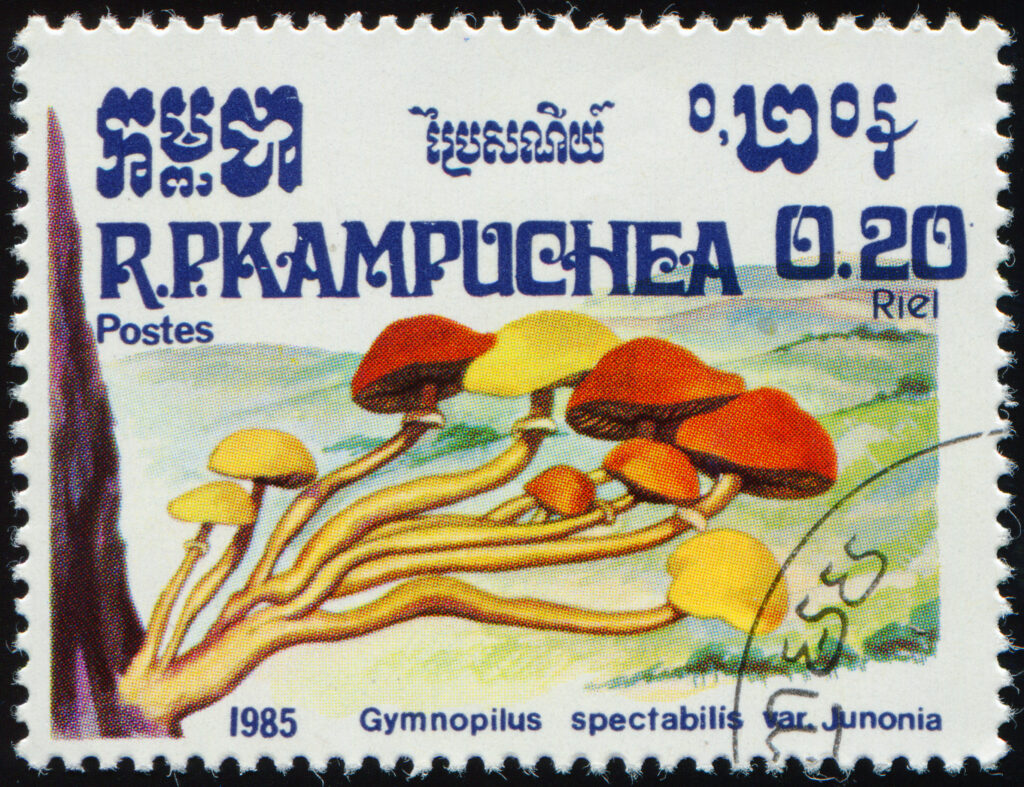
If you want to reliably have a psilocybin experience, then you don’t want to consume Gymnopilus junonius. There have been reports of this species containing psilocybin (in low amounts), but there are many other sources refuting this. It is possible that it has been confused with a subspecies or lookalike that has psychoactive effects.
Supposed psychoactive effects are why Gymnopilus junonius has been called the laughing gym mushroom. This is because psilocybin is known to produce uncontrollable laughter.
You could experience the effects of psilocybin and psilocin by consuming one of the laughing gym mushroom’s subspecies, which are reported to contain these compounds, but these may also contain neurotoxic chemicals, which can result in unpleasant effects.
Is Gymnopilus junonius edible? Due to its bitter taste, it is considered inedible, although some people do consume them and claim to experience subjective effects. This may be due to the presence of the kava-like compounds bis-noryangonin and hispidin.
If you want to use Gymnopilus junonius, you should be aware of the law surrounding psilocybin mushrooms where you live, as mushrooms containing this psychedelic compound are illegal in most countries around the world.
If you want to grow and possess psilocybin-containing mushrooms, be aware of the legal risks.
Yet, as we will describe in greater detail, it is not clear if this species does actually contain psilocybin and psilocin. If it doesn’t, then you will not face any legal risks, even if the kava-like compounds it contains are psychoactive (since these are not controlled substances).
On the other hand, if the laughing gym mushroom contains psilocybin in small quantities, this would make it illegal to cultivate and possess, even if these concentrations are very low.
RELATED: 10 Most Potent Magic Mushrooms
Identifying Gymnopilus Junonius And Its Lookalikes
If you want to source these mushrooms by picking them, then you need to know what they look like. After all, the laughing gym mushroom has some lookalikes that you should be aware of.
Where Does Gymnopilus Junonius Grow?
Knowing where the laughing gym mushroom grows is the first necessary step in identifying it in the wild. One must be aware of the kind of habitat these mushrooms grow in, as well as the countries they exist.
Habitat

The laughing gym mushroom grows in dense clusters on tree stumps, logs, or tree bases of hardwoods and conifers. It is most common in moist, lowland wooded areas near rivers. Gymnopolis junonius grows in Spring to early Winter, depending on the location.
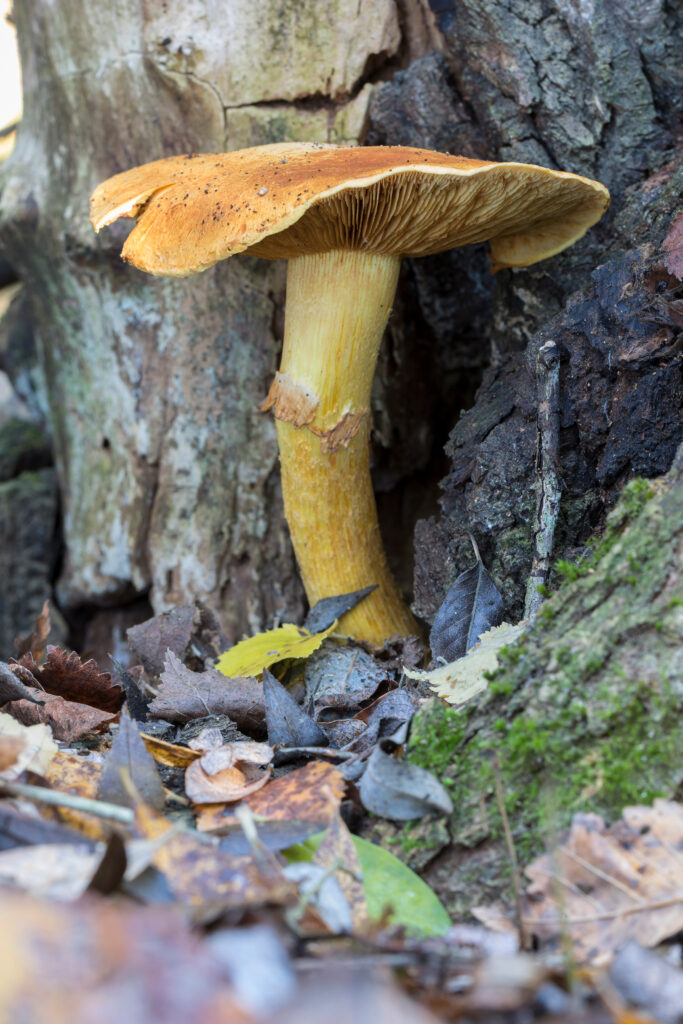
Distribution
Gymnopilus junonius is found in Europe, Australia, New Zealand, Asia (widely distributed in Japan), Africa, and South America. It does not occur in North America, although some similar-looking species do, such as Gymnopilus ventricosus on the west coast and Gymnopilus luteus and Gymnopilus subspectabilis in the midwest and east.
How To Identify Gymnopilus Junonius
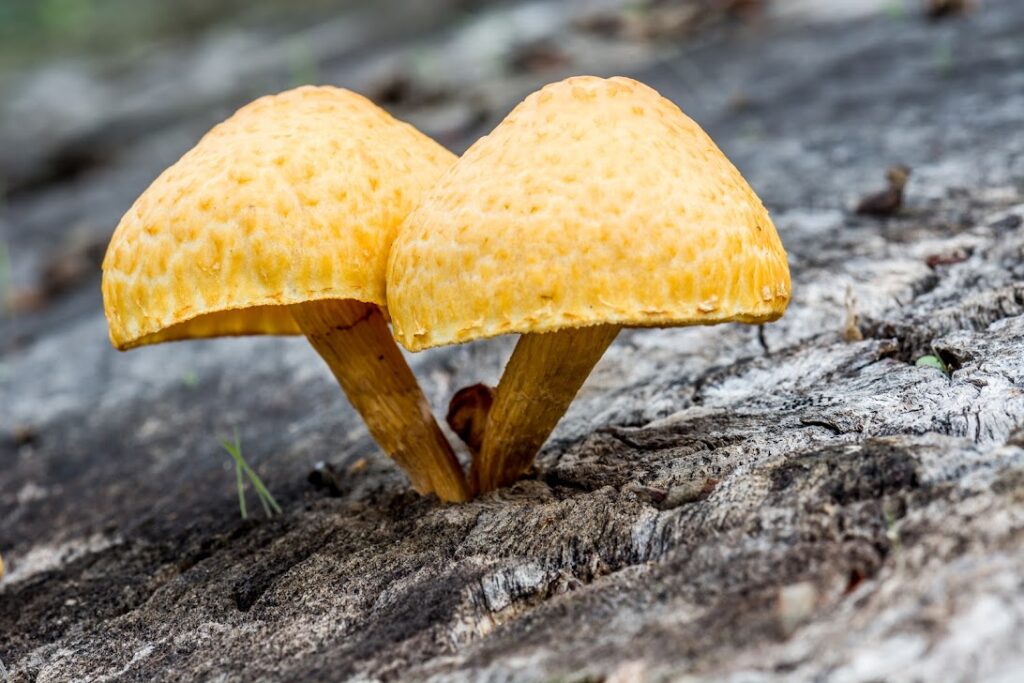
To identify Gymnopilus junonius mushrooms, you need to know its distinctive features, which are as follows:
- Cap (pileus). The diameter is typically 4-20 cm, although some exceptional specimens have been discovered with caps measuring 30 cm in diameter. The cap is initially convex, with an in-rolled margin; it eventually flattens out but retains a slight umbo (central raise area). It is bright yellow-orange in younger specimens and orange/brown or reddish-brown in older ones, and has a dry scaly surface.
- Gills (lamellae). A yellow cortina (veil) covers the gills of immature fruit bodies, breaking and shriveling to leave fragments around the rim of the cap and the stipe. The crowded gills are adnate with a broad attachment to the stipe. They are straw yellow to buff at first, changing to a bright rusty color as the spores mature.
- Stem (stipe). 5-25 cm long, 1-5 cm thick, and often narrower at the base. The robust stem is the same color as the cap. Its surface is fibrous below the ring, which soon gathers spores and turns rusty brown. At the base, the stipe is either bulbous or clavate (club-shaped).
- Odor. Mild.
- Taste. Bitter, making it inedible.
We can see from the color of the mushroom why it also goes by the spectacular rustgill. It is also worth noting that unlike psychoactive relatives in the Psilocybe genus, the laughing gym mushroom does not typically bruise blue.
Laughing Gym Mushroom Lookalikes
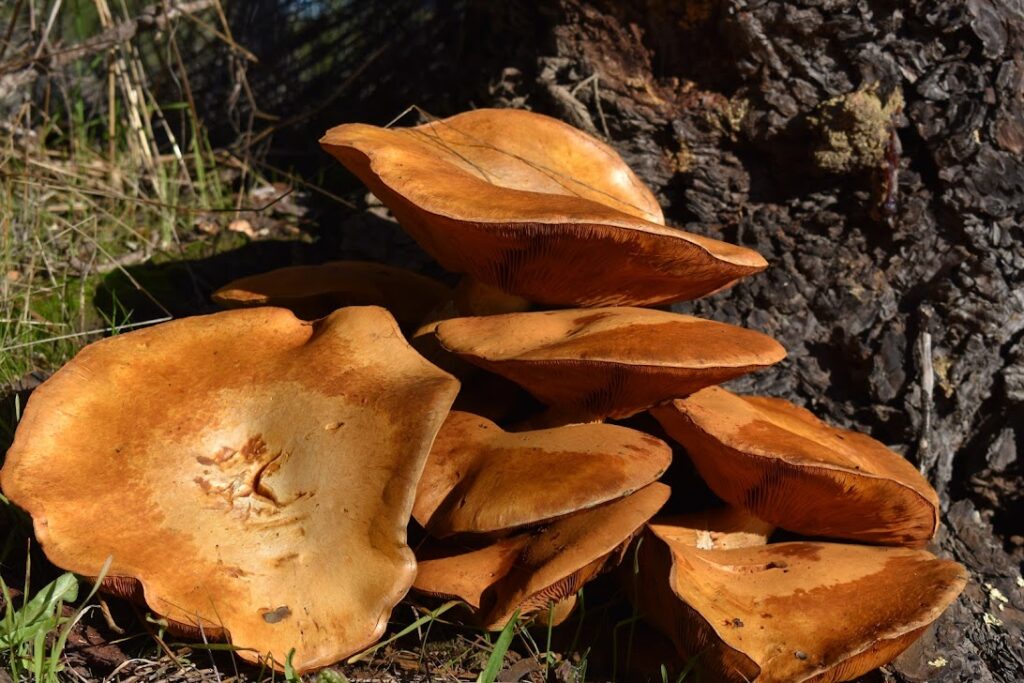
Gymnopilus junonius is often mistaken for Gymnopilus ventricosus, which contains no psilocybin, and Gymnopilus luteus and Gymnopilus subspectabilis, which do. It also resembles Armillaria mellea (honey fungus) and Omphalotus olivascens.
There are some ways you can tell the laughing gym mushroom apart from its lookalikes.
For example, honey fungus looks similar, but it is ringless and has a white spore print. This differs from Gymnopilus junionus, which has a ringed stem and rusty orange spores.
Phaeolepiota aurea is similar looking, but it is quite rare. Moreover, its spores are a light yellow or brown. And Gymnopilus penetrans has a similar appearance, too, and shares a similar habitat to the laughing gym mushroom, although it is yellow-brown, smaller in size, and the stem ring is absent.
To help with identifying the correct species, you could:
- Take a field guide for your area
- Have some forums handy on your phone, such as Shroomery’s “Mushrooms Hunting and Identification” subforum
- Use the iNaturalist app, which provides identifications after uploading photos of mushrooms
- Join local Facebook groups (members may be aware of local lookalikes)
Also, even if you do successfully end up finding these mushrooms, you might still want to avoid collecting and consuming them, due to the presence of neurotoxins. In fact, it makes more sense to pick its safer and more psychoactive lookalikes and to try to avoid collecting Gymnopilus junonius.
How To Grow Gymnopilus Junonius Mushrooms
There are not many guides out there on how to grow Gymnopilus junonius, and it would be difficult to find a grow kit for this species. (Some vendors sell grow kits for Gymnopilus luteofolius, for instance, but this is because it definitely contains psilocybin and in high enough quantities that will cause you to trip.)
If you want to grow the laughing gym mushroom, you can do so by growing it outdoors, although this may be a lengthy process.
Since Gymnopilus junonius likes to grow on logs, you can cultivate them yourself in a similar way. This involves drilling holes into a log and inserting impregnated dowels (hardened dowels inoculated and colonized with mushroom mycelium) into them. You then seal each dowel in place.
You should then wrap your inoculated logs lightly in plastic and leave them in a cool, shady area for 8-12 weeks. After this time, remove the plastic, then stack the logs in damp shade. Mushrooms should appear in Autumn and Spring after 6-18 months, and on larger logs, they can return every few months for up to five years.
Of course, you may not want to wait this long for the mushrooms to grow. If you also don’t have the option to pick them, you should consider whether it’s really worth it to cultivate Gymnopilus junonius in order to experience psychoactive effects, especially since it’s relatively easy to grow magic mushrooms species (like Psilocybe cubensis).
WANT TO SAVE MONEY IN THE LONG RUN? Get Your Own Mushroom Grow Kit Here
Potency Of Laughing Gym Mushrooms
It is unclear what the potency of the laughing gym mushroom is, or if it even contains any psilocybin whatsoever. It has been reported to contain the compound, yet Stijve and Kuyper (1988) failed to find any psilocybin in it.
How To Dose Laughing Gym Mushrooms
Remember that the laughing gym mushroom is poisonous. Even if it contained psilocybin, this would only be in very small amounts based on the reports that exist. So the volume of mushrooms you would need to consume to produce psychedelic effects would likely make you sick before you even reached those effects.
Moreover, this mushroom is very bitter in taste. This is another reason why it would be difficult to consume a high enough dose of them.
Also Read: Everything you need to know about Banded Mottlegill Mushrooms (Panaeolus Cinctulus)
Laughing Gym Mushroom Effects
Kava-like compounds may be responsible for the laughing gym mushroom’s psychoactive effects. Kava contains kavalactones, which have various psychoactive effects, including reduced anxiety and stress, and increased feelings of sedation and well-being.
However, Bettye Rees, an Australian authority on the genus Gymnopilus, has discovered the presence of hispidin and bis-noryangonin in many but not all specimens of the genus in Australia. In any case, if you were to consume specimens that contained these compounds, these would not cause psychedelic effects like psilocybin and psilocin would.
Gymnopolin, the neurotoxin that results in the mushroom having a bitter taste, may also explain why consuming Gymnopilus junonius leads to psychoactive effects.
There are varying reports when it comes to the effects of consuming the laughing gym mushroom. Some just find it makes them sick (sometimes with severely unpleasant physical effects), whereas others claim to experience psychedelic effects, as you would when consuming well-known species and strains of psilocybin mushrooms. If consuming Gymnopilus junonius does result in a psilocybin experience, you can expect the effects to last 4-6 hours.
Regardless, the laughing gym mushroom is poisonous, so do you want to risk experiencing unpleasant effects in order to trip? Remember, there are other species available to consume. Some people just want to try them out of curiosity. But keep in mind that severe reactions are possible. It makes sense that when signing up for a psychedelic experience you would want to reduce the risks as much as possible.
FROM OUR PARTNER: Discover The Power of Psilocybin Ceremonies in a Supportive Retreat Setting

